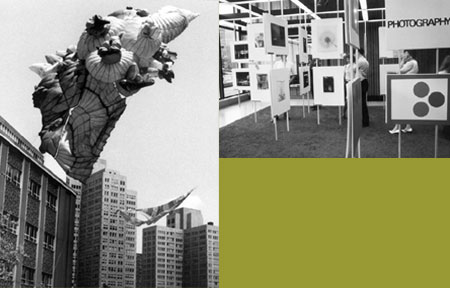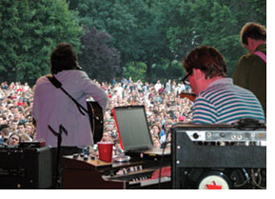Back

Three Rivers Arts Festival,
1972.
 Popular
musical artists are a staple of the Arts Festival today. Popular
musical artists are a staple of the Arts Festival today.
In the summer of 1960, a four-day arts extravaganza featuring
drama, music, paintings, and sculpture took place in downtown
Pittsburgh’s Gateway Plaza. People were blown away
by this first-ever Three Rivers Arts Festival— especially
by the rain and high winds on the festival’s last
day.
Conceived in 1959 by the Women’s Committee of
Carnegie Museum of Art,
the festival, modeled after the Boston Arts Festival, was
a way to bring free art to the public while showcasing
local artists. Today, the festival is still sponsored by
Carnegie Museum of Art, but its funds are raised separately
from corporate, foundation, public, and individual patrons.
Scale was small those first few years, but every year
saw something new or expanded. The number of days lengthened,
the festival spread into Point State Park and then through
town, food booths and a family area were introduced, and
in 1982 a film festival debuted (now operated by Pittsburgh
Filmmakers). But the focus never strayed from art.
“
Our mission always was and still is to connect the community
to the arts,” says Three Rivers
Arts Festival Executive Director Elizabeth Reiss. “The
festival has the unique opportunity to give art the large
audience it deserves. And, in addition to producing our
own programming,
we co-develop and host other organizations’ projects,
which gives us the chance to put new art in front of new
audiences.”
“
It offers the kooky to the serious,” says Bill Lafe,
a long-time festival board member, “that’s
been a hallmark of the festival for 30 years and continues
to be so.”
Ella Fitzgerald skatted at the 1982 festival;
artist Elaina Myrinz covered the Westinghouse Building’s
front 14 stories in more than 4,500 square feet of nylon
cloth;
and live demonstrations—from raku firing to bronze
casting—have amazed audiences over the years.
Every
year the festival showcases one piece of public art “ranging
from the pleasant and unassuming to the controversial,” says
Lafe. But nothing shook things up more than 1990’s
Hunky Steelworker. Created by New Mexico artist Louis Jimenez,
the towering sculpture of a laborer was viewed by many
Pittsburghers as an ethnic insult. “The artist didn’t
do his research,” says Lafe. “He thought ‘Hunky’ was
a word of praise. It caused such an outcry.”
The
2005 festival is likely to raise a few eyebrows, too. “Each
year we try to push the envelope a little more and stretch
the boundaries of what people consider art,” says
Reiss. “This year, we’re going to erect a sculptural
skate ramp in Point State Park, and if everything turns
out okay, local artist Stacy Levy will be taking her work
to the river by placing multiple long strands of spherical
floats in the river radiating out like an eyelash from
Point State Park.”
Today the festival is held over
17 days and it brings in artists from across the country
and around the world. While
every year brings something new and unusual, the rain,
however, stays the same. But as Lauren Urbschat, the festival’s
communications coordinator, says: “Have you ever
been in Pittsburgh for 17 days and not seen it rain?”
This year’s Three Rivers Arts Festival runs June
3-19. For details about artists and events, visit
www.artsfestival.net.
Back
| Top |